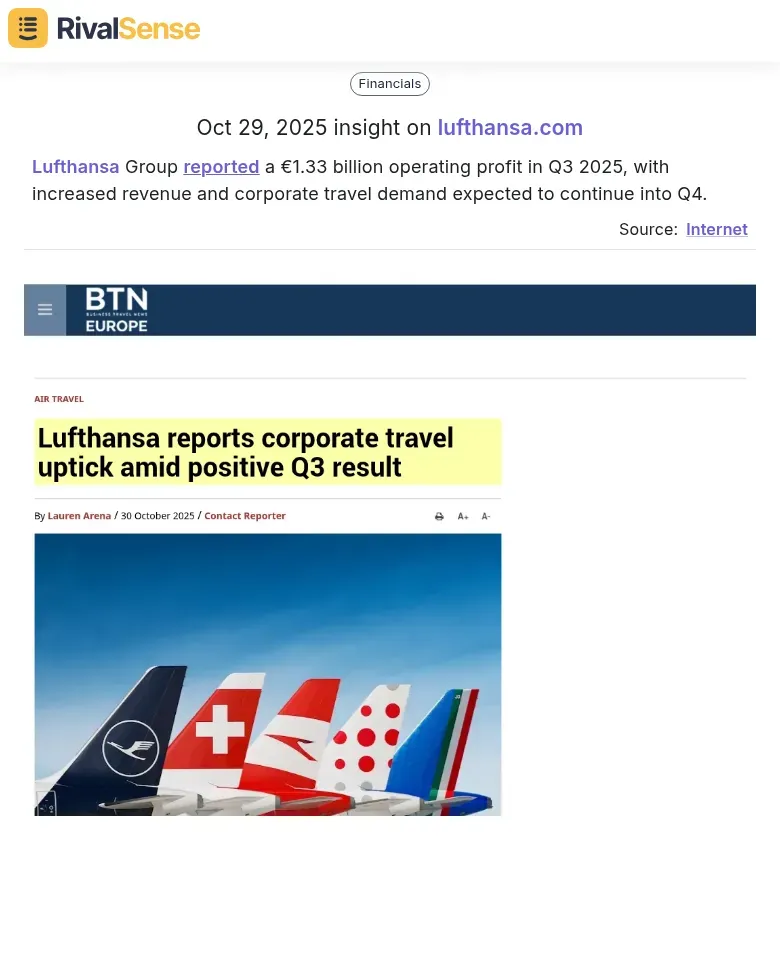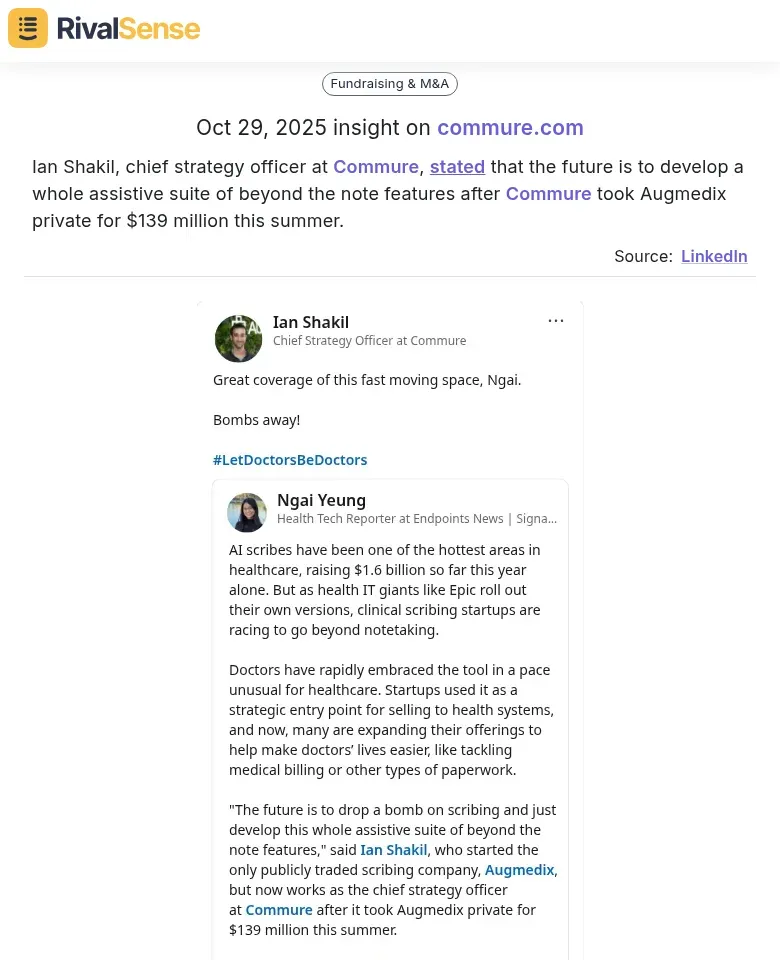Mastering Competitor Tracking: Financials, Fundraising, and M&A for B2B Leaders
Keeping a close eye on competitor financials, fundraising, and M&A activities is more than just gathering data—it's a vital strategy for B2B leaders to stay agile and informed. By understanding these elements, you can uncover market trends, predict shifts, and refine your own business approach. For instance, a rival's sudden revenue surge in a niche area might highlight emerging opportunities, while their fundraising rounds could signal impending expansions or innovations. This proactive monitoring helps you anticipate moves, avoid surprises, and maintain a competitive edge in fast-paced industries.
To get started, focus on actionable steps like setting up alerts for quarterly reports and using specialized tools. Consistently analyzing this intelligence allows you to adapt quickly, whether it's by adjusting your product roadmap or securing resources to counter competitor advances. Remember, the goal isn't just to watch—it's to act on insights that drive growth and resilience.
Analyzing Competitor Financial Performance for Market Intelligence
Diving into competitor financials provides a clear window into market dynamics and helps you benchmark your own performance. By examining reports and metrics, you can identify strengths, weaknesses, and industry trends that inform your strategic decisions. For example, tracking revenue growth and profit margins reveals demand patterns, while cash flow statements indicate financial stability during economic fluctuations.
A practical example from RivalSense illustrates this: Lufthansa Group reported a €1.33 billion operating profit in Q3 2025, with increased revenue and corporate travel demand expected to continue into Q4.  Understanding such financial performance is valuable because it helps you assess market health, anticipate sector booms or downturns, and align your resource allocation accordingly. If a competitor like Lufthansa shows strong results, it might indicate rising demand in related B2B services, prompting you to explore similar avenues or bolster your offerings.
Understanding such financial performance is valuable because it helps you assess market health, anticipate sector booms or downturns, and align your resource allocation accordingly. If a competitor like Lufthansa shows strong results, it might indicate rising demand in related B2B services, prompting you to explore similar avenues or bolster your offerings.
Actionable Tips:
- 📊 Monitor Key Metrics: Regularly review revenue, EBITDA margins, and cash reserves to spot trends.
- 🔔 Set Up Alerts: Use tools to get notified of SEC filings and financial disclosures for real-time updates.
- 📈 Compare Annually: Benchmark your performance against competitors to identify gaps and opportunities.
Checklist for Financial Analysis:
- [ ] Subscribe to financial news and earnings call summaries
- [ ] Create a dashboard to track competitor metrics
- [ ] Correlate financial data with market events (e.g., product launches)
- [ ] Assess debt levels and liquidity to gauge resilience
Monitoring Fundraising Activities to Predict Competitor Moves
Fundraising activities offer a roadmap to competitor ambitions, revealing where they plan to invest and grow. By analyzing funding rounds, you can decipher their strategic priorities, from R&D focuses to market expansions. This insight allows you to prepare counter-strategies, such as accelerating your own innovations or strengthening customer relationships to retain market share.
Consider this RivalSense insight: Arya Health secured $18.2 million in Series A funding on October 29, 2025 to develop AI agents for automating administrative tasks in post-acute care.  Tracking fundraising like this is crucial because it highlights growth trajectories and potential market disruptions. If a competitor secures significant funding for AI development, it signals a push into automation, urging you to evaluate your tech stack or explore partnerships to stay relevant.
Tracking fundraising like this is crucial because it highlights growth trajectories and potential market disruptions. If a competitor secures significant funding for AI development, it signals a push into automation, urging you to evaluate your tech stack or explore partnerships to stay relevant.
Actionable Steps:
- 💰 Analyze Round Details: Look at funding amounts, lead investors, and stated use of funds to predict moves.
- 🔍 Review Investor Profiles: Check platforms like Crunchbase to understand backer credibility and long-term support.
- 🚀 Anticipate Expansions: Use announcements to foresee geographic or product launches, and adjust your strategy early.
Quick Tips:
- Set up alerts for press releases and regulatory filings.
- Maintain a log of competitor funding history to spot patterns.
- Assess how fundraising aligns with their recent product updates or hires.
Decoding M&A Strategies for Competitive Advantage
Mergers and acquisitions are powerful indicators of where competitors are heading, often revealing their strategic bets on new technologies or markets. By decoding these deals, you can uncover opportunities for your own growth, whether through partnerships, acquisitions, or internal innovations. This approach helps you stay ahead of industry consolidations and emerging threats.
Here's a relevant example from RivalSense: Ian Shakil, chief strategy officer at Commure, stated that the future is to develop a whole assistive suite of beyond the note features after Commure took Augmedix private for $139 million this summer.  Insights into M&A activities like this are valuable because they expose strategic intents, such as moves into integrated solutions or talent acquisitions. If a rival acquires a tech firm, it might prompt you to assess if you should build similar capabilities or seek alternative alliances to compete effectively.
Insights into M&A activities like this are valuable because they expose strategic intents, such as moves into integrated solutions or talent acquisitions. If a rival acquires a tech firm, it might prompt you to assess if you should build similar capabilities or seek alternative alliances to compete effectively.
Practical Advice:
- 🤝 Evaluate Deal Structures: Cash-heavy purchases may indicate urgency, while stock deals suggest long-term alignment.
- 📋 Assess Acquired Assets: Look into the tech stacks, talent, and customer bases of acquired companies.
- 🎯 Adjust Your Plans: Use M&A insights to inform your own acquisition or partnership strategies.
Checklist for M&A Analysis:
- [ ] Monitor deal announcements via news and tracking tools
- [ ] Analyze how acquisitions affect market share and pricing power
- [ ] Consider cultural fit and integration risks in your evaluations
- [ ] Document insights for team discussions and strategic reviews
Integrating Financial, Fundraising, and M&A Insights into Business Strategy
Combining insights from financials, fundraising, and M&A creates a holistic view that drives informed decision-making. This integration helps you connect dots between competitor actions and market shifts, enabling proactive adjustments to your business strategy. For instance, if a rival's fundraising aligns with aggressive hiring, it might signal a product launch, prompting you to ramp up your marketing efforts.
Start by consolidating data from diverse sources like financial databases and press releases. Use this to scenario-plan for potential disruptions, such as market consolidations from M&A waves. Regularly updating your analysis ensures you're not just reactive but strategically agile, turning competitor intelligence into a sustainable advantage.
Actionable Steps:
- 🔄 Conduct Quarterly Reviews: Map competitor health against your goals to identify strategic gaps.
- 🛠️ Leverage Tools: Automate data collection with platforms that track disclosures and announcements.
- 📝 Scenario-Plan: Prepare for various market conditions based on competitor moves, like funding rounds or acquisitions.
Tips for Integration:
- Prioritize high-impact competitors to focus your efforts.
- Use dashboards to visualize trends and share insights with your team.
- Align findings with your resource allocation and innovation pipelines.
Conclusion: Building a Proactive Competitor Tracking Framework
Establishing a robust competitor tracking framework ensures you continuously gather and act on critical intelligence. By automating alerts and conducting regular analyses, you can stay ahead of market changes and competitor maneuvers. This disciplined approach transforms data into actionable strategies, fostering long-term growth and agility.
Incorporate tools like RivalSense to streamline this process—it tracks competitor product launches, pricing updates, events, partnerships, and more, delivering consolidated reports weekly. For example, using RivalSense, you could have caught the Lufthansa profit surge or Arya Health's funding round early, allowing timely strategic adjustments.
Final Checklist for Implementation:
- [ ] Set up automated alerts for financial, fundraising, and M&A activities
- [ ] Create a centralized dashboard for key metrics
- [ ] Schedule weekly monitoring and monthly strategic reviews
- [ ] Document and share insights to align your team
Call to Action: Ready to turn competitor insights into your advantage? Try RivalSense for free at https://rivalsense.co/ and get your first competitor report today! This tool helps you track everything from financials to media mentions, so you can anticipate moves and stay ahead effortlessly.
📚 Read more
👉 Unlocking Competitor Insights: The Power of Tracking Management Changes
👉 Key Account Performance Dashboard: The Ultimate Guide for Strategic Account Management
👉 Advanced Tactics to Analyze Competitor Marketing Strategy on Influencer Platforms
👉 How Reddit's Legal Action Against Perplexity AI Revealed Competitor Vulnerabilities
👉 LinkedIn Trend Analysis: Uncover Competitor Pricing Advantages
